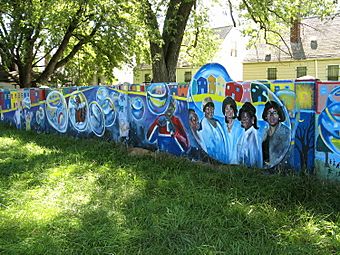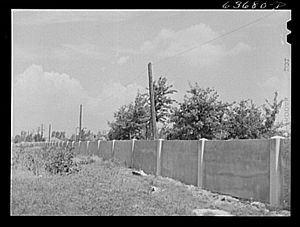Detroit Wall facts for kids
Quick facts for kids |
|
|
Birwood Wall
|
|

The Detroit Wall as seen from Alfonso Wells Playground in August 2011
|
|
| Location | Along the alleyway between Birwood Ave. and Mendota St. from Eight Mile Rd. to Pembroke Ave. Detroit, Michigan |
|---|---|
| Built | 1941 |
| MPS | The Civil Rights Movement and the African American Experience in 20th Century Detroit MPS |
| NRHP reference No. | 100006100 |
| Added to NRHP | January 27, 2021 |
The Detroit Eight Mile Wall, also called the Birwood Wall, is a special wall in Detroit, Michigan. It is about 1 foot (0.30 meters) thick and 6 feet (1.8 meters) tall. The wall stretches for about half a mile (0.8 kilometers).
This wall was built in 1941. Its original purpose was to keep Black and White families living in separate areas. This was done only because of their race. Today, the wall no longer separates people by race. Since 1971, most people living on both sides of the wall have been Black.
The wall starts near Van Antwerp Park on Pembroke Avenue. It goes north almost to 8 Mile Road. A part of the wall without houses nearby is in Alfonso Wells Memorial Playground. In 2006, people from the community worked together to paint this part of the wall. The murals show things like children playing, singers, and Rosa Parks on a bus. They also show people protesting for fair housing.
Contents
Why Was the Detroit Wall Built?
Detroit's Growth and Housing Challenges
After World War I, many jobs opened up in Detroit. This was because many white men went to fight in the war. Black citizens moved to Detroit for these new job opportunities. This caused a big change in the city's population.
When white men came back from the war, there was more competition for jobs and homes. Housing was scarce, meaning there weren't enough homes for everyone. White residents often got most of the private housing. Black residents were pushed into less desirable areas. The Great Depression made the housing problem even worse.
New Deal Programs and Unequal Aid
President Franklin D. Roosevelt started programs called the New Deal. These programs aimed to help people buy homes. The Home Owners Loan Corporation (HOLC) and the Federal Housing Administration (FHA) were created. They offered easier payment plans for homes, spread over many years.
These programs helped many white working-class families in Detroit buy homes. However, Black residents often did not benefit. Local governments decided how federal money was spent. These local governments were mostly made up of white politicians. So, white residents received federal housing help, but Black residents did not.
Redlining and Segregation
White residents in Detroit wanted to keep their neighborhoods racially separated. Local rules helped prevent Black families from moving into white areas. HOLC members acted as federal appraisers. They decided which areas were "safe" for banks to give loans.
Neighborhoods were given ratings: A, B, C, or D. An "A" neighborhood was usually white and wealthy. People there could easily get a loan. A "D" neighborhood was often where Black residents lived. People in these areas were usually prevented from getting loans. This practice was called redlining.
Redlining kept neighborhoods racially separated in Detroit. If a Black family moved into a white neighborhood, the neighborhood's rating could drop. This would lower property values for everyone, causing tension. Between 1930 and 1950, most homes bought in the U.S. used FHA loans. But less than two percent of these loans went to non-white buyers.
Without financial help, Black neighborhoods became very different from white ones. Homes were expensive to buy or fix. This led to poorer living conditions. Some white residents thought that Black residents would ruin any neighborhood they moved into.
Public Housing Debates
The New Deal policies also caused debates in Detroit. People argued about public housing versus private home ownership. Public housing was meant to help Black people. Private home ownership was for middle-class white people.
Many believed that public housing would harm the private housing market. They thought affordable homes for lower-income people would interfere with real estate. Community groups wanted to keep their neighborhoods separated. They worked against public housing projects.
The Eight Mile Community
The Eight Mile/Wyoming neighborhood, where the wall is, was greatly affected by the housing crisis. This area was outside the city and used to be farmland. Residents worked together to build their own small homes. They were proud of what they built.
In 1938, a survey found that residents here were among the poorest in Detroit. But they were also very independent. Over 90% of them owned their single-family homes.
Building the Birwood Wall
Because of redlining, the Eight Mile area was very poor. After World War II, a developer wanted to build a new all-white neighborhood there. But HOLC appraisers thought it was too risky. This was because it was so close to a Black neighborhood. So, the FHA would not lend money for construction.
The developer made a deal with the FHA. They would get loans if they built a wall. This wall would be one foot thick and six feet high. It would run for half a mile, separating the Black and white neighborhoods.
Contractors and realtors used the wall to attract white buyers. They said the wall would "protect them." It was meant to keep property values high and keep the neighborhoods racially separated. This wall became known as the Detroit Eight Mile Wall, the "Detroit Wailing Wall," and the Birwood Wall.
The Wall Today
The Birwood Wall still stands in the Eight Mile area. Its purpose has changed a lot. It is no longer a racial barrier. For current residents, it is now like a backyard fence or a canvas for art. People living there know the wall was built to divide races. But now, Black people live on both sides of it.
In 2006, a part of the wall was turned into a mural by local residents and activists. It helps people remember history. It also represents a hopeful and more colorful future for the community.
In 2021, the Birwood Wall was added to the National Register of Historic Places. This recognized its importance to the Civil Rights Movement and African American history in 20th Century Detroit.


